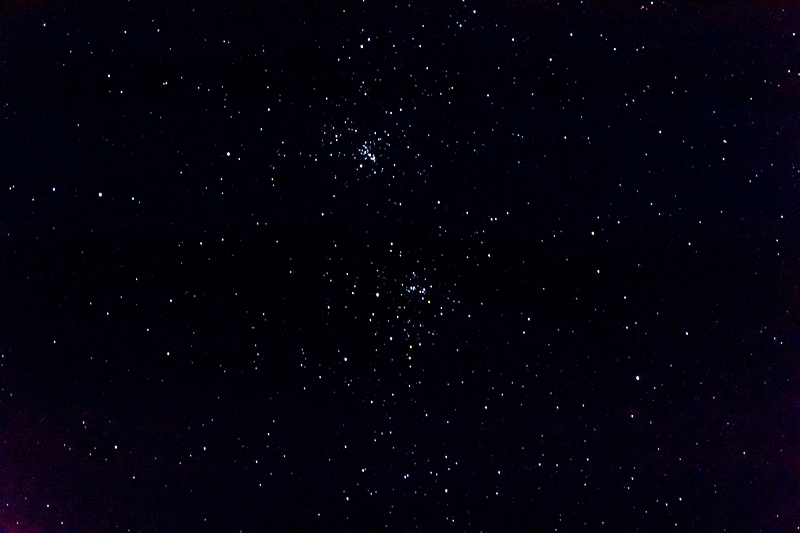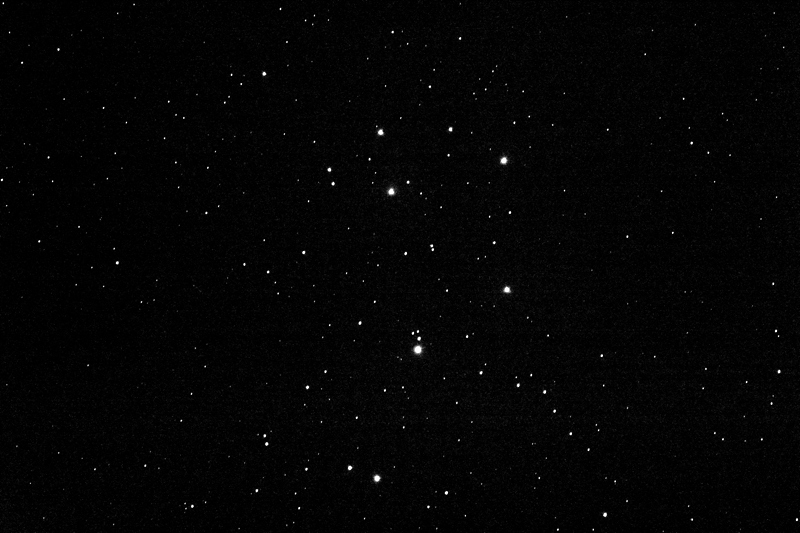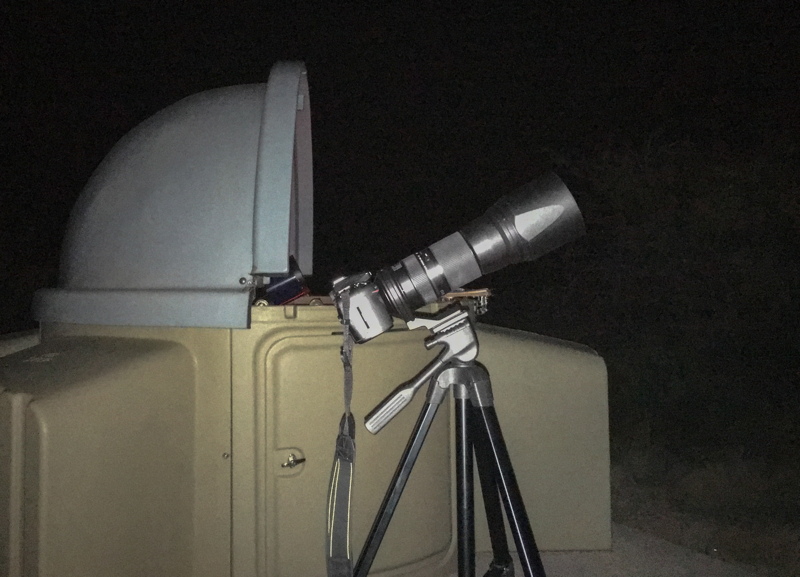D7200 DSLR: M13, Double Cluster, Pleiades, Orion Nebula;
iPhone 6s Plus: Sky, Blue Snowball, Crab Nebula
Posted: 9 December 2015
Following the brief clearing for Monday morning's Venus Occultation, clouds returned and the sky was mostly cloudy by sunset. Tuesday, 8 December 2015, was mostly cloudy until late afternoon, when the sky began clearing.
|
Open: Tuesday, 8 December 2015, 1807 MST Temperature: 64°F |
Session: 894 Conditions: Mostly clear; clouds low in west, high in east |
1815 MST: viewed M13 (Great Hercules Globular Cluster), 83X, very low in the western sky (but clear of clouds). Saw a faint polar orbiting satellite pass through the field-of-view. Then viewed M13 using the Celestron 12x70 binoculars. Next, set up to image M13 using my new Tamron 150-600mm lens on my Nikon D7200 DSLR. This is a slight crop from the full-frame image, f/6.3, 1/2sec, ISO 102400, FL 600mm:

Next, pointed the camera at the Double Cluster and took this f/6.3, 1sec, ISO 25600, FL 600mm photo:

1845 MST: thin clouds were now visible in much of the sky. Set up for iPhone 6s Plus sky imaging using NightCap Pro. Mounted the iPhone on the GorillaPod. 1853 MST: took this image of the eastern sky with NCP (Long Exposure, Light Boost, ISO 8000, 1/3sec, 1 minute exposure), showing the constellations of Auriga (left) and Taurus (right) with the Pleiades at the top:

Next, did a star trails image with NCP (Light Trails, Light Boost, ISO 8000, 1/3sec, 10 minute exposure), showing Auriga and Taurus and some plane trails (lights at the lower left are from the house):

I then went back outside of the observatory and took this photo (not cropped) of M45 (Pleiades) with the D7200 DSLR and Tamron lens, f/6.3, 1sec, ISO 102400, FL 600mm:

1920 MST: viewed M1 (Crab Nebula), low in the east, 83X.
1946 MST: viewed NGC7662 (Blue Snowball, planetary nebula), 83X. Then set up to image the Blue Snowball using the iPhone 6s Plus, afocal 154X. I had previously imaged NGC7662 with my iPhone 5s at 77X. This would be a good test of the iPhone 6s Plus. Mounted the iPhone on the 8" LX200-ACF using the Orion SteadyPix Universal Smartphone Telescope Photo Mount. Used NightCap Pro (Long Exposure, Light Boost, ISO 8000, 1/3sec, 15 seconds exposure) for this uncropped photo (inset shows the Blue Snowball magnified):

That's a pretty impressive iPhone photo of this Deep Sky Object!
1959 MST: slewed back to M1 (Crab Nebula). Tried to photograph M1 with the iPhone afocal 154X but it was too faint. However, at 77X this was the resulting image with NightCap Pro (Long Exposure, Light Boost, ISO 8000, 1/3sec, 1 minute exposure):

2103 MST: removed the iPhone from the telescope and viewed M42 (Great Orion Nebula), 83X. Then went outside of the observatory to image M42 using the D7200 and Tamron lens. This is how the camera looked in front of the observatory:

This is the Orion Nebula (slightly cropped), f/6.3, 1sec, ISO 25600, FL 600mm:

And this is the Orion Nebula (slightly cropped), f/6.3, 1sec, ISO 102400, FL 600mm:

Note: using an ISO of 102,400 on the D7200 DSLR yields a black-and-white image.
I tried to capture the Flame and Horsehead nebula with the Tamron lens at 600mm using an unguided, 1 second exposure at ISO 102400. (Unguided exposures longer than 1 second trail at 600mm.) The Flame Nebula was just barely visible but no Horsehead Nebula.
2123 MST: ended imaging. 2129 MST: last look at M42, 83X.
|
Close: Tuesday, 8 December 2015, 2140 MST Temperature: 56°F |
Session Length: 3h 33m Conditions: thin clouds |
Comments are welcome using Email. If you are on Twitter you can use the button below to tweet this report to your followers. Thanks.
Cassiopeia Observatory Home Page
Copyright ©2015 Michael L. Weasner / mweasner@me.com
URL = http://www.weasner.com/co/Reports/2015/12/09/index.html
